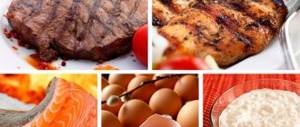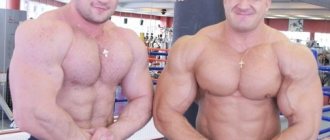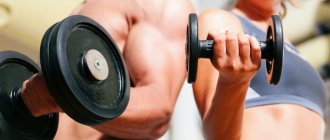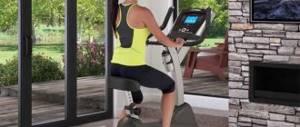Whether it is possible to lose weight and gain muscle mass at the same time is a controversial and not fully studied issue. For quite a long time, most sports and fitness specialists were of the opinion that it was impossible to combine these processes, but recently studies have appeared that indicate the opposite.
The classic theory is that a person can either lose weight or gain muscle. To achieve each of these goals, you need to structure your nutrition and training process in a certain way - and these will be completely different strategies.
In this article we will tell you about the latest developments on this topic and try to figure out whether it is possible to combine the two processes in one training program.
Muscle hypertrophy
To begin with, let’s understand in general terms what gaining muscle mass is. This means muscle hypertrophy, that is, an increase in muscle thickness.
The number of muscle fibers in a person is determined genetically and does not change over life. Therefore, muscle growth occurs at the cellular level, due to the components of the muscle cell: contractile units of myofibrils and/or the amount of sarcoplasm. Sarcoplasm is the semi-liquid content of a muscle cell, which contains energy resources - mitochondria, as well as reserves of creatine phosphate, glycogen, etc.
Sarcoplasmic hypertrophy does not provide a large increase in muscle volume, but it does provide an increase in muscle endurance. This type is predominantly developed in track and field athletes.
Muscle growth due to myofibrils , on the contrary, provides a more significant increase in muscle volume, which allows one-time maximum effort. This type is typical for athletes who engage in weightlifting, where short-term “jerks” are required, for example, lifting a barbell.
However, with any training, both of these types of muscle development are involved to one degree or another.
The process of muscle growth is influenced by a number of factors:
1. Mechanical load. Training leads to muscle microtrauma, which allows you to start recovery processes and stimulate growth. In addition, as a result of stress, creatine and lactic acid accumulate in the muscles, which also affect muscle growth.
2. Amino acids. The building material for muscles is proteins, or more precisely, the amino acids that make up proteins. If there is a deficiency of amino acids in the body, then muscles will not grow.
3. Hormones. Gaining muscle mass is influenced by the growth hormone somatotropin, as well as testosterone and insulin.
4. Age. After 25-35 years, the level of growth hormones decreases. At the same time, the susceptibility of muscle cells to growth stimuli decreases.
How to lose weight and build muscle at the same time
The goal of your training is to achieve an accurate and sensitive calorie intake. Your body needs a surplus of calories to grow and a deficit to burn fat.
To maintain hyperplasia (muscle fiber growth), you must remain in a very small calorie deficit, with sufficient protein (and amino acids).
When we talk about a very small calorie deficit, we mean one so tiny that your body barely registers it. Aim to keep it to no more than 10% of your calorie intake.
Let's say you need to eat 2,500 calories to maintain your weight. So now, to lose fat and get ripped, you should consume 2,250 calories.
This small deficit will help get rid of accumulated fat in the body and will not lead to the breakdown of previously pumped up muscles. You shouldn't feel hungry. We're playing the long game here.
This can really help provide important tips/rules for those learning how to build muscle and lose fat at the same time.
#1 Get good sleep
Indeed ? The article is about how to eat, exercise and supplement your food, and the first thing we recommend is sleep?
Exactly ! Sleep is the most important thing you can give your body, whether you want it big or thin. Lack of sleep can negatively impact the effectiveness of any caloric deficit, no matter what you are in (NCBI, 2011).
Sleep is free, requires no special equipment, and is available to all of us.
This is not about everyone having the opportunity to sleep 9 hours a day. Children, shift work and stress will make you pay for it.
Sleep more. Sleep better. Get as much sleep as you can. Your body will repay you.
Along with weight loss, sleep is essential for muscle growth. Without enough sleep, you won't be able to reap the benefits of diet or exercise.
You'll absorb nutrients better and feel more motivated to exercise and have more energy to do it.
The goal is to create a dark and cool atmosphere in your bedroom, turn off electrical appliances, avoid taking your phone with you, and get 7 to 9 hours of sleep at night.
#2 Give yourself enough time
Don’t expect quick results, because you can quickly gain weight only with a significant increase in adipose tissue, and we don’t need that.
But how do you keep a balance between these two extremes? This requires a sensible approach. You can't just waste calories or create a severe calorie deficit. You need a suitable plan and a lot of patience.
Achieving that big, muscular, lean look takes a lot of time, so make sure you give it as much as it takes.
If you have marked an end date, then extend it.
The key is not to rush the process of physical transformation or body recomposition, so give yourself plenty of time (and add a couple of weeks in reserve).
#3 Consume lean protein
Protein is protein... for the time being. What do we mean?
All protein has 4 calories per gram of macronutrient. It's just math, but when your physique transformation goals become extremely specific, it becomes necessary to get the macronutrients right.
You want to build muscle and become slimmer, right? Protein is required for both of these purposes.
Gaining muscle requires consuming protein to produce amino acids (the building blocks of cells). And in case of weight loss, protein is necessary to preserve muscle and obtain energy, which is difficult to convert into deposits on the sides. Your job is to choose the best type of protein to achieve your goal.
By the way, we recommend excellent exercises for losing weight in the abdomen and sides for women and men.
You need to get more lean, leucine-rich protein found in fish, lean poultry, and quality whey protein powder and other types of protein supplements. Here you can see products containing protein, and here you will find products for muscle growth that are best used in your diet.
#4 Don't skimp on healthy fats
Eat fat to become thin? It sounds crazy, but in practice it works, you just need to get the balance right.
Healthy fats, especially Omega 3 fatty acids found in foods like fatty fish, flax and walnuts, support your body, hormones and brain.
These essential fats help your body stay healthy, energetic and strong so you maintain muscle and can lose fat.
So if you skimp on Omega 3 fats and feel sluggish, your recovery will take a hit and your immune system may suffer.
Take the recommended serving of a quality fish oil or other omega-3 supplement every day all year long (add fat to your macros if you're tracking).
#5 Drink plenty of fluids
In fact, water cannot help you build muscle or lose weight, but it is an extremely important part of your body transformation plan.
Beginners and amateurs
Research confirms that exercising and eating enough protein leads to simultaneous weight loss and muscle gain.
| At the same time, the body’s response to physical activity will be completely different for those who have been involved in sports for a long time and for those who have started exercising for the first time. |
This statement especially applies to those who have a fairly high BMI. The effect is enhanced due to the fact that previously there was no stimulus for muscle growth.
The human body can adapt to anything, including training. Playing sports is stressful for the body, especially for an unprepared person. Under the influence of this stress, a newcomer, performing even small work of an unusual nature, begins to actively transform.
In the first month or two, a person actively loses weight, muscles begin to appear, and well-being improves. This is called the recency effect. But over time, the same loads become increasingly easier to perform: the muscles adapt to the load that is regularly offered to them, the nervous system is at rest and almost does not react to training, weight loss stops, or even fat mass gain begins.
To continue the process, it is necessary to complicate the training: increase the weights, speed up the run, artificially create a “rollback”, refusing or reducing the intensity of training for a short time. By changing something in the training process, you will again and again achieve the effect of novelty, albeit short-term.
| Most scientific sources are of the opinion that the effect of simultaneous fat burning and muscle gain is definitely possible for beginners in training. |
As for those who have been practicing for a long time, there is an opinion that in order to combine the process of fat burning and muscle growth, it is necessary to maintain a slight energy deficit in combination with a high protein content in the diet, supplementing this with intense strength training .
| It is a moderate decrease in calories that allows you to achieve an increase in muscle mass, since only in this case the hormones that affect growth - testosterone and somatotropin - are produced in sufficient quantities. |
With the described diet, the exerciser loses weight due to a slight energy deficit, and at the same time builds muscle mass in a normal or almost normal manner.
At the same time, in men, with a significant reduction in calories and high physical activity, testosterone levels decrease significantly, which negatively affects muscle growth.
Women's testosterone levels are already significantly lower than men's, so they are less likely to gain muscle mass. With severe caloric restriction combined with intense training, muscle growth will definitely not happen.
Increasing your caloric intake can also slow down muscle growth if it is not balanced. For example, an increase in calories from fat leads to a decrease in the production of both growth hormone and testosterone.
How to gain muscle mass by burning fat, but without losing weight?
For most guys who actively lift and want to lose fat, the important question is: “How not to lose muscle mass when you lift and lose weight?” . Many dudes have excess fat that they want to lose. But I want to pump up a lot of quality meat, most often to be big and scary. Why, in a nutshell, do you need to gain muscle mass? In order to create an energy-intensive muscle corset. The presence of a muscle corset helps us keep bones, joints and organs in a reliable frame, protecting them from damage. In addition, the muscle corset is very energy-intensive and forces you to consume calories without saving in reserve. Of course, if you continue to engage in at least some physical activity.
This article is relevant not only for those who want to gain muscle mass, but also for those who just want to simply lose weight, because one of the best ways to lose fat is to build up meat , which is much heavier than fat, which is easy like shit.
Eat more protein foods
Not only does protein help build muscle, but it is also the most filling of the nutritional trio: proteins, fats, and carbohydrates. Having enough protein, you will feel fuller much longer than from carbohydrate or fatty foods. Sometimes it seems to us that we can only eat when we add bread or something fatty. In fact, it is nothing more than a habit that forces us to consume more food from carbohydrates. Over time, bad eating habits go away, and eating becomes easier and healthier.
Power training
Cardio quickly becomes less effective, and interval cardio also causes you to burn more calories. Intense strength training forces you to burn calories for days after the workout is over. Repairing and rebuilding damaged muscle fibers requires energy that could otherwise be stored around the waist. The metabolic effect of strength training increases the amount of proper hormones such as testosterone and growth hormone.
Rethink your relationship with snacks and snacks
Either stop snacking throughout the day, or include something completely different in your diet, such as fruit. But you shouldn’t get too carried away with them, because they are very high in calories. But dried berries are very possible. Dried berries, fresh berries and apples are your ideal snack. Also remember about coffee, by chance you can “drink” stupid calories, almost your daily requirement.
In any unclear situation, drink water
You need to drink a lot of water. Read more about this in the article about the amount of water consumed per day. The best way to get rid of hunger is to drink water. Sometimes we want to eat only because our treacherous stomach, which is accustomed to eating at a certain time or in a certain amount, wants to be filled. So pour yourself a glass of water and drink it slowly, sadly. Wait for 15 minutes. The hunger will pass. So you will have to accustom yourself to eat strictly at a certain time.
Walk and move every day
Walk every day. Take the stairs without an elevator, go a few stops to your house, or walk around the neighborhood. This especially needs to be done when you have problems with time and it is not always possible to train fully 3-4 times a week. During your lunch break, find time to walk. During your workday, take a walk around the office or along the hallways to get some exercise and shake off some fat.
Dream
Quality sleep is an extremely important topic for those who actively exercise. Lack of sleep, which we love to neglect until a certain age, can ruin several training sessions. Research shows that people deprived of sleep feel hungrier much more, are more prone to snacking, and are much quicker and more willing to eat and buy sweets and alcohol. At best, that's 300 extra calories a day, which you definitely don't want if you're losing weight. In addition, lack of sleep negatively affects the production of hormones that are beneficial for muscle growth and fat loss.
Eat breakfast
You can sometimes skip breakfast, but it is advisable to always eat it. I am categorically against the article about frequently skipping breakfast; if you don’t eat breakfast for a long time, nothing good will come of it. Skip breakfast once or twice, but skipping breakfast every day is always bad. The problem is that we don't have enough time for breakfast, but more often than not we don't have the motivation and self-control to get up early and cook it for ourselves. It seems incredibly tiring, it seems pointless, because sleep is always better. But in reality, an extra 15 minutes of sleep never helped anyone, sometimes even making them more sleepy. After all, a 15-minute nap is not complete sleep. You should always remember about the calorie content of food and the production of necessary hormones, but also about sores. However, there is no doubt and normal confirmed evidence that most people who have lost weight and managed to keep it off consume a healthy breakfast. Additionally, recent research arguing against skipping breakfast entirely shows that calories “saved” from breakfast in the morning are often replenished by snacking in the evening and throughout the day. Skip breakfast to let your hormones rage, but don't do it often. Personally, during the two control weeks without breakfast, I think I even gained some weight, and definitely not more meat.
Eat vegetables and greens
I know how many dudes hate greens like spinach. I personally found only a few ways to eat it normally - with olive oil and garlic. And another sandwich with adjika. But this crap is just phenomenally healthy, so it would be nice to learn how to eat it. Imagine that there will be a mass death of livestock or vegetarians will take over the world. Personally, it helped me become addicted to greens and vegetables. Salted cheese, olive oil and kilograms of spices that my wife sprinkles on salads also helped me. It’s even delicious when served with buckwheat and boiled chicken.
The same goes for Brussels sprouts and broccoli. If you want, you can still learn to eat them; moreover, they unexpectedly turn out to be tasty, for example, in cheese soup.
Bread
Heck, I'll probably get some negative comments, but someone has to say it. Modern high-grade white bread is absolutely useless. You can find out this from any textbook for a technologist or commodity expert. All the most useful parts: the bran, the germ and several other parts of the grain are removed, because the fat they contain interferes with storage. The higher the grade of bread, the less benefits it has, but it is more tasty, fragrant and sweet due to the breakdown of carbohydrates under the influence of saliva into monosaccharides. Most of the bread on store shelves is not harmful, but absolutely useless. Considering that most people in Russia openly abuse it, it’s still harmful. Whole grain bread is a good idea, but there is one catch: most of these breads are not made from whole grains, but simply interspersed with seeds and grains. If you want to lose weight, you need to stop eating bread every day. You will argue that it is difficult, but it is not. Everything is quite real.
The Right Fats
The right fats in our diet will help burn fat. Sources of normal fat: lean meat, fish oil, vegetable oils: rapeseed, olive, sunflower, peanut.
Found specifically for: CocoBay Article Source: Brodude
0 0 vote
Rating
HIIT
Usually, when they talk about fat burning, the first thing they mention is cardio training, and when they talk about gaining muscle mass, the emphasis is on strength training. Therefore, the mechanisms described above largely speak about the effect of strength training on body composition. However, there is another type of training that can influence changes in body composition - high-intensity interval training (HIIT).
Many studies on HIIT show a huge surge in the hormones adrenaline and norepinephrine during and after exercise. These hormones stimulate fat burning, as they are responsible for launching lipolysis, the mechanism for breaking down fat.
Remarkably, the effects of epinephrine and norepinephrine are found in the deep layers of abdominal fat (visceral fat surrounding the internal organs). This shows that HIIT can affect not only subcutaneous fat, but also prevent obesity of internal organs.
When it comes to gaining muscle mass from HIIT, it's worth remembering professional sprinters and comparing their appearance and body structure to marathon runners. HIIT training predominates in the arsenal of sprinters, unlike long-distance runners.
Long-term cardio exercise has a damaging effect on muscles. When glycogen reserves in the muscles and liver and intramuscular fat are depleted, the body begins to extract energy from muscle protein, that is, to break down muscles in order to somehow obtain energy to continue working and reduce its energy costs to ensure the functioning of muscle tissue.
Unlike cardio training, during HIIT the energy reserves from the carbohydrates consumed by a person do not have time to be depleted, since the workout consists of short sessions of intense work and low-intensity rest. Thus (with a sufficient supply of carbohydrates from food), the body simply does not need to destroy muscle protein, which allows maintaining muscle volume.
As a result, the process of increasing muscle mass seems to close in a cycle: preserved and strengthened muscle mass continues to maintain an increased level of testosterone, which, in turn, creates an anabolic background that promotes muscle hypertrophy.
Our regular author Dmitry Yakovina, editor-in-chief of the online magazine Pro Status, tells how you can build muscle and burn fat at the same time.
— There is one question that haunts many. Because the answer to it is most often not optimistic. “Is it possible to build muscle and burn fat at the same time.” In most cases, fitness specialists or simply experienced bodybuilders answer: no, you can’t. However, I would not be so categorical, first of all, because it is necessary to clarify what scale of these processes we are talking about.
So, any phenomenon has a “scale”, that is, a certain degree of expression of this phenomenon. And if we proceed in principle from whether it is possible to simultaneously build muscle mass and burn fat, then the answer is unequivocal: YES! This is an absolutely natural course of events for our body. For example, at night, when we do not receive energy from the gastrointestinal tract, which in physiology is called the post-absorptive period, our body actively extracts energy from fat reserves. It is for this reason that up to 80% of the daily intake of somatropin is secreted at night. A normal person sleeps at night and does not eat, because nature has adjusted the biorhythms of one of the main lipolytic hormones in such a way as to ensure a stable flow of energy during night sleep. Somatropin stimulates lipolysis, and lipolysis gives us fatty acids ready for consumption. At night, we actively build muscle tissue, and part of the fat energy goes to ensure protein synthesis. That is, at least during the night period, we build muscle and burn fat AT THE SAME TIME.
Those who like to read scientific research should have noticed that the result of many of them is an increase in lean muscle mass and a simultaneous loss of fat. We are talking about experimenting with training regimens, diets, or taking pharmacological drugs and nutritional supplements. As a small example, I will give a few similar ones.
Thus, in the “Korean Journal of Physiology and Pharmacology” in 2014, a study was published showing that experiment participants who took ursolic acid as a supplement and regularly worked out in the gym gained an average of 1.17 kg of muscle mass and lost 3 kg over 8 weeks. fat
Italian scientists published the results of a study in the Journal of the International Society of Sports Nutrition that examined the performance of experienced gymnasts during a 30-day period of following a keto diet (no more than 25 grams of carbohydrates per day). The total number of kilocalories per day for the athletes was 1970. Protein intake was high: 2.8 g per kilogram of body weight per day. At the end of the experiment, the gymnasts added an average of 800 grams of muscle mass (which is not bad in 30 days for already experienced athletes, and not even bodybuilders) and lost 2 kg of fat.
Even more impressive results were announced in the journal Clinical Endocrinology and Metabolism in July 2013. In particular, scientists studied the effect of testosterone injections on fat deposits in the body of non-exercising men. All participants in the experiment were on the same diet, the energy value of which was 35.82 kilocalories and 1.3 grams of protein per kilogram of body weight per day. That is, a 100-kilogram man consumed 3582 kilocalories and 130 grams of protein. After 20 weeks, participants who received testosterone injections of 300 mg and 600 mg per week increased lean muscle mass by 10 and 17%, respectively, while reducing total body fat by 10%.
There are very, very many such studies, and none of the scientists has ever been surprised by the fact of changes in body composition, expressed in the growth of lean muscle mass and loss of fat mass. This is normal, it is natural for the human body and especially for a physically active person. You just need to understand that such changes are possible only within certain, fairly limited limits. Of course, when a person radically goes into mass gain, eating a bunch of extra calories, then there can be no talk of any fat loss. The situation is similar with “drying”. Trying to lose 10 kg of fat in a month, it is unlikely that with the level of energy deficit required for such a result, we will also be able to increase “meat”. But the fact remains a fact. It is possible to grow muscle and burn fat at the same time. Under certain conditions, on a limited scale.
Dmitry Yakovina openly about Russian bodybuilding, Men`s Physique and the Russians’ chances at Olympia (video)
#fat #muscle mass #muscles
Previous Drinking plenty of fluids may be more harmful than dehydration
Next Do you need to rest during training?
Leave a comment (Cancel)
conclusions
So, being able to burn fat and build muscle at the same time is not a myth, especially if you haven't worked out before and are just starting to workout. If you have been training for a long time, this possibility remains, but, most likely, it will be less pronounced than for those new to training.
High-intensity interval training has a high potential for increasing muscle mass while losing weight. Including functional exercises in training can increase this effect, since the maximum number of muscle groups is involved, including deep muscles.
Another option for preserving and strengthening muscle mass while losing weight is to alternate strength training (with and without weights) with HIIT training.
Author: Margarita Popova, adaptive physical education specialist, training department specialist #Sekta
References: 1. Donnelly JE, Sharp T. et al., Muscle hypertrophy with large-scale weight loss and resistance training, Am J Clin Nutr. 1993 Oct;58(4):561-5. 2. Body recomposition: Adding Muscle While Losing Fat – Q&A. 3. Lyle McDonald, The Ultimate Diet 2.0. Advanced Cyclical Dieting For Achieving Super Leanness, 2003. 4. LH secretion and testosterone concentrations are blunted after resistance exercise in men (Journal of Applied Physiology September 1, 2001 vol. 91 no. 3 1251-1258). 5. Endocrine system, sport and physical activity / Transl. from English / Ed. W. J. Kremer and A. D. Rogol. - Kyiv: Olympic Literature, 2008. 6. Boutcher, SH 2011. High-intensity intermittent exercise and fat loss. Journal of Obesity, doi: 10.1155/2011/868305. 7. Dr Emil Hodzovic, High-intensity functional training = efficient exercise. 8. The Mechanisms of Muscle Hypertrophy and Their Application to Resistance Training (Journal of Strength & Conditioning Research: October 2010 - Volume 24). 9. Kots Ya.M. Sports physiology Textbook for physical education institutes. - M.: Physical culture and sport, 1998. - 200 p. 10. Brad Schoenfeld USING SPECIAL TRAINING METHODS THAT CAUSE MAXIMUM MUSCLE HYPERTROPHY, Translation by S. Strukov.
Muscle training. How to burn fat and not muscle
A properly designed set of workouts “How to burn fat and not muscle” will help to maintain, and maybe even grow, muscle mass.
At the same time, it will reduce the percentage of fat in the body. The theory can be found in the article linked below. Practice training and what exercises to do, read on this page. Training theory
- Theory. We burn fat and build muscles at the same time. The complex that we offer is complex at first glance. But if you decide to follow it unconditionally, you can easily build muscle and burn fat. The goal of many in the gym is to gain high-quality muscle mass and at the same time burn fat immediately...
Differences between training for weight loss and training for muscle building.
Details
This article contains answers to the most popular questions about the correct structure of the training process for various purposes. What is the difference between working out to build muscle and exercising to lose weight? Remember or print out these simple but important rules and get the maximum effect from your efforts.
For one workout, the human body requires from 80 to 150 grams of glycogen, which is a derivative of sugar and accumulates in the muscles. For 40 minutes of any cardio or strength training, the body primarily uses glycogen, and only then energy from its own fat.
Glycogen is the body's storage of carbohydrates, which is located in the liver and muscle tissue. The main function of glycogen is to store energy that the body can use during physical activity.
In order to knock fatty acids out of a fat cell, it is necessary to create a low level of sugar in the blood, and only then these acids will be transported through the blood to the liver, where they will be used for energy.
Eating carbohydrates with a high glycemic index keeps blood sugar levels high, blocks fat-burning processes, and the human body stops using its own fat as an energy source.
The glycemic index shows the effect of foods on blood sugar levels after consumption. That is, this is a conventional unit showing the ratio of the rate of absorption of this product and the rate of absorption of glucose, whose glycemic index is taken as the standard and is equal to 100 units.
The purpose of the warm-up is to warm up the body. Therefore, it lasts no more than 5-8 minutes, otherwise a too long warm-up wastes a lot of glycogen and does not leave energy for strength training.
A cardio workout performed after a strength workout will have zero effect, since muscles need energy to grow, the body must start the recovery process after a strength load, which is only possible during rest periods.
Training for muscle building (strength) and physical exercise for burning fat should be carried out separately and with a break between them of at least 5 hours.
If your workout is done at a heart rate of 130-160 beats per minute, this is an endurance workout, it burns fat. If your heart rate during training is 160 beats per minute or higher, this is strength training that helps build muscle mass.
Nutritionists say there is scientific evidence that low heart rate training uses energy primarily from fat.
| PULSE RATE | CARBOHYDRATES USED, % | FATS USED, % |
| 70-80 | 15-25 | 75-85 |
| 124 | 65 | 35 |
| 142 | 74 | 26 |
| 159 | 90 | 10 |
With a pulse of 70-80 beats/min. up to 85% of energy is taken from fats, and only 10% from fats at a pulse of 159 beats per minute and the remaining 90% from carbohydrates, respectively. This is why low heart rate training is very popular.
Cardio machines - treadmill, elliptical, exercise bike - give the same load as aerobics.
During strength training, in order to raise your heart rate to 170 beats per minute, you need to add weights, with which you can do 6-10 repetitions per set.
The starting weight for strength training is half your body weight for the shoulders and chest and the same weight for the legs and back with 6-10 repetitions per set.
Duration of physical activity:
- Strength training should last no more than 40 – 60 minutes.
- Gaining muscle mass (for naturals): 40 – 45 minutes
- Gaining muscle mass (for a chemist): 60 – 75 minutes
- Maximum strength: the duration of the training can be up to 2 hours (this is due to the fact that the rest between approaches is very long)
- Muscle relief: 50 – 60 minutes
- Weight loss: 60 – 75 minutes
- Light weight training with 15-30 repetitions, lasting 60 minutes with short breaks, burns fat and tones muscles, but does not damage them.
I hope the advice presented here will help you and the return on your efforts will be much greater. If you have any questions, write them in the comments. If you liked the article, please like it.
Commonly read with this article:
- How to lose weight and build muscle at the same time.
- Three rules for beautiful buttocks.
- How to lose weight and not lose muscle mass.
- Diet and exercise.
We recommend reading
Tags: exercise , training , heart rate , muscle mass
Add a comment
Comments
Roman 25.11.2015 19:55 Thank you for the article, very succinct and informative. I didn’t know such nuances about training. Due to my busy schedule, I sometimes practice training using Jillian Mikes videos. Have you encountered it?
Reply | Reply with quote | Quote
2 1 elison 09.29.2015 08:11 Thank you, I didn’t know about glycogen. I always thought that 30-40 minutes of running helps not only train muscles, heart and lungs, but also helps burn fat. But no, you need to run longer 
Reply | Reply with quote | Quote
1 Nadezhda1 09.21.2015 13:45 And I thought that in order to build muscle, you need to eat before training, and in order to lose weight, you don’t eat for a while before and after, but it turns out it’s just time that matters?
Reply | Reply with quote | Quote
Update list of comments RSS feed of comments for this entry











